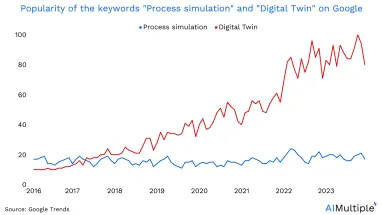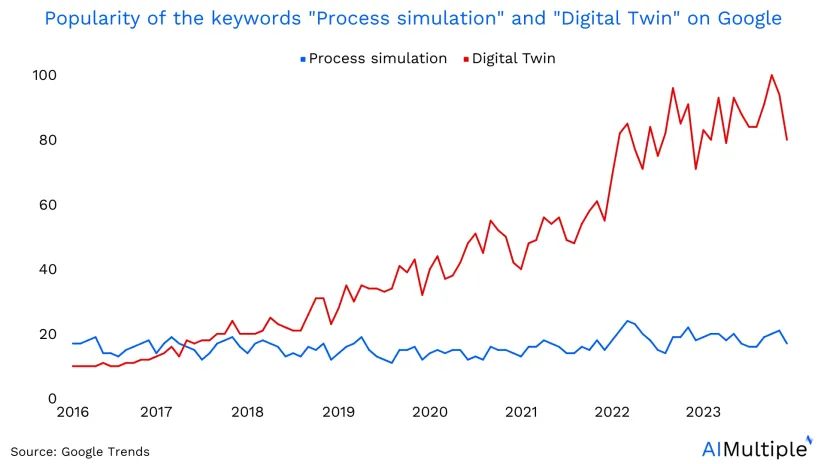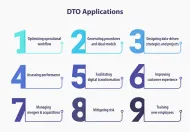What is Process Simulation & Its Best 3 Use Cases in '24?


Process simulation can help optimize workflows, develop data-driven process models, and enhance customer experience. Vendors refer to simulation capabilities as process simulation, digital twins and a digital twin of an organization (DTO), which could confuse business analysts who want to benefit from these capabilities. The figure above from the Google trends shows how digital twin replaces process simulation on Google searches over the last 5 years.
This research explains process simulation, its three benefits to businesses, and compares it against other solutions, such as digital twins and DTO.
What is process simulation?
Process simulation is a digital representation of real-life processes and systems, such as customer support centers or manufacturing facilities. It has been applied to designing, developing, analyzing and optimizing processes in manufacturing, chemistry, education, finance & sales.
Process simulation software allows users to consider every component, test them, and refine them by establishing an accurate virtual environment. As a result, business analysts can investigate and develop optimal processes without interrupting their daily operations.
DTOs vs. process simulation
Similar to process simulation, the digital twin of an organization (DTO) is a virtual replica of processes. The vendors use two different concepts for process simulation because they want to highlight that digital twins are dynamic virtual representations, relying on actual process data rather than static visuals based on historical data.
However, we find the difference between the two concepts blurring since the process simulation vendors continue to add capabilities to their solutions so that the software can leverage real-time process data and generate dynamic models.
What are the benefits of process simulation?
1. Improve your processes for an efficient workflow
Process simulation enables users to visualize the business processes by considering every component, including employees involved in the process, resources allocated, activities done, and the time of these activities. Consequently, business analysts can assess and improve the performance of the employees and functions. They can investigate their operations in detail and evaluate the efficiency of their operations. Thus, these analysts can identify the bottlenecks in processes and eliminate them to reduce time and monetary waste, while increasing efficiency.
For example, process experts can benefit from process simulation to monitor and understand complicated processes, such as procure to payment or credit verification process. The employees can simulate the credit approval flow and visualize each activity, time duration of each steps, and the employee responsible for tasks. Based on the constant monitoring, experts can pinpoint the variations that prolong the customer’s approval.
2. Advance your process models for low risk and cost
The analysts can simulate and compare the process model against the actual processes. They can also run “what-if” scenarios based on the actual process data to obtain the best fitting process models. As a result, they can test all plausible process models in real-world systems and optimize the processes accordingly at low risk and cost.
Going back to the customer credit verification example, a bank can simulate the verification process by using customer scores, personal reviews and credit rating inspections. Then, the bank can determine approval rates and the optimal number of employees required for the verification tasks. They can run “what-if” and counterfactual scenarios to measure the expected ROI for each model so that they can advance their credit approval model and have the opportunity of comparing it to the actual processes.
3. Customize your processes for a better customer experience
Process simulation can be helpful to customize the services, products or proposals. The teams that execute processes related to customers can simulate these operations and proposals by leveraging customer process data. By delivering insights from such simulation, business analysts and sales and marketing teams can evaluate the unique proposals and services based on the customer segments or feedback.
For example, the bank that improved its customer credit verification model can also utilize the same data to generate personalized offers for each customer based on the customer data. Based on their segments, the bank can automate or simplify the approval procedure for existing clients and customers with high priority. A shorter time for approval eventually brings a better customer experience.
Further Reading
If you want to learn more on the ways you can grasp, improve and customize your business processes, feel free to read our in-depth articles on process mining:
- What is process mining & Why should businesses use it?
- The Complete Guide to Process Mining and Digital Twins
- Top 10 Open Source and Free Trial Process Mining Tools
If you believe your business can benefit from process management solutions such as process mining, you can start reviewing our data-driven lists of software.
And, if you still need more help, we are here to find the right vendor for you:



Comments
Your email address will not be published. All fields are required.